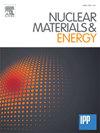On the melting threshold of toroidal gap edges of ITER divertor tungsten monoblocks under repetitive ELM transients
IF 2.7
2区 物理与天体物理
Q1 NUCLEAR SCIENCE & TECHNOLOGY
引用次数: 0
Abstract
Damage to plasma-facing components from transient heat loads, such as Edge Localized Modes (ELMs), poses a critical challenge for ITER’s tungsten (W) divertor monoblocks (MBs). Under the modified ITER Research Plan, the full actively cooled W divertor will be installed from the outset, while the provisional inertially cooled first wall used during ITER’s Start of Research Operations (SRO) will be replaced by the final, actively cooled variant before DT operation. Thus, damage to the divertor during SRO must be kept to the absolute minimum. This study investigates toroidal gap (TG) edge melting during repetitive Type I ELM loading in the SRO phase, first predicted in Gunn et al. (2017) to occur at much lower energy densities than for the top surface. The focus will be on the planned deuterium H-mode plasmas at half nominal toroidal field (2.65 T) and with plasma currents in the range 5–7.5 MA. Self-consistent 3D heat transfer simulations are performed to determine the ELM fluence thresholds for TG edge melting and assess the impact of ELM mitigation via frequency variation to identify the required mitigation level to minimize the melt damage at the ITER divertor during the SRO discharges. It is found that ELM frequencies above 20 Hz are necessary to completely avoid TG edge melting, even under worst-case assumptions. Moreover, for roughly equivalent conditions to those studied with a more simplified approach in Gunn et al. (2017), we find an approximate 25% lower heat load, which can be considered a reasonable agreement in view of the uncertainties in the ELM energy fluence specification and in the treatment of ion orbit dynamics in the gap vicinity.
重复ELM瞬变下ITER导流器钨块环面间隙边缘熔化阈值的研究
瞬态热负荷对等离子体组件的损伤,如边缘局域模式(elm),对ITER的钨(W)分流器单体(mb)提出了严峻的挑战。根据修改后的ITER研究计划,将从一开始就安装完全主动冷却的W导流器,而在ITER开始研究操作(SRO)期间使用的临时惯性冷却第一壁将在DT操作之前被最终的主动冷却改型所取代。因此,在SRO过程中,对转向器的损坏必须保持在绝对的最低限度。本研究调查了SRO阶段重复I型ELM加载期间的环形间隙(TG)边缘熔化,Gunn等人(2017)首次预测,这种熔化发生在比顶表面低得多的能量密度下。重点将放在计划中的氘h模等离子体上,在半名义环形场(2.65 T)下,等离子体电流在5-7.5 MA范围内。进行自一致的3D传热模拟,以确定热重热边缘熔化的ELM影响阈值,并评估通过频率变化缓解ELM的影响,以确定所需的缓解水平,以最大限度地减少SRO放电期间ITER转化器的熔体损伤。研究发现,即使在最坏情况下,也需要高于20 Hz的ELM频率来完全避免TG边缘熔化。此外,在与Gunn等人(2017)采用更简化方法研究的条件大致等效的情况下,我们发现热负荷降低了约25%,考虑到ELM能量影响规范和间隙附近离子轨道动力学处理的不确定性,这可以被认为是一种合理的一致。
本文章由计算机程序翻译,如有差异,请以英文原文为准。
求助全文
约1分钟内获得全文
求助全文
来源期刊

Nuclear Materials and Energy
Materials Science-Materials Science (miscellaneous)
CiteScore
3.70
自引率
15.40%
发文量
175
审稿时长
20 weeks
期刊介绍:
The open-access journal Nuclear Materials and Energy is devoted to the growing field of research for material application in the production of nuclear energy. Nuclear Materials and Energy publishes original research articles of up to 6 pages in length.
 求助内容:
求助内容: 应助结果提醒方式:
应助结果提醒方式:


